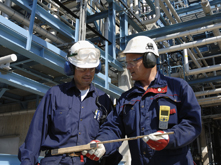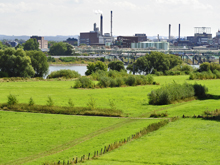ITS offers measurement and treatment of industrial noise in all sectors, this activity being well in line with its slogan "Choice soundscapes, everywhere".
General considerations on industrial noise
Industrial noise, in relation to noise emissions from machinery, equipment and facilities, e.g. production or processing, is a consequence of the human activity to which attention must be paid for various reasons.
|
|
|
On the one hand, workers exposure to noise is a vital aspect of hygiene and safety in companies. In Europe in general, and therefore in France in particular, regulatory limits exist and must therefore be respected.
Thus, with regard to industrial noise, Decree No. 2006-892 of 19 July 2006 concerning the safety and health requirements applicable in the event of exposure of workers to the risks arising from noise and amending the Labor Code transposes into french law the directive 2003/10/CE: daily noise exposure levels exceeding 80 dB (A) and / or a peak sound pressure level above 135 dB (C) are above the limit triggering the action.
On the other hand, disturbances for the neighborhood must be prevented or fought, being, in France, especially based on the emergence concept i.e. the difference between the A-weighted equivalent continuous pressure levels of the ambient noise (installation in operation) and the residual noise (in the absence of noise generated by the installation, but measured over the period of operation of the installation).
Thus, in the case of industrial noise, allowed emergence values must be respected by Classified Installations for the Protection of the Environment (ICPE) and by other sites so as not to cause noise nuisance for the neighborhood: these values depend on the period considered and the level of ambient noise.
For the period 7 am - 10 pm (except Sundays and public holidays), the allowed emergence is 6 dB (A) for an ambient noise level between 35 dB (A) and 45 dB (A) and 5 dB ( A) for an ambient noise level greater than 45 dB (A).
For the period 22h - 7h (and for Sundays & public holidays), the allowed emergence is 4 dB (A) for an ambient noise level between 35 dB (A) and 45 dB (A) and 3 dB (A) for an ambient noise level greater than 45 dB (A).
In relation to the protection of the environment against industrial noise: other limitations exist, in relation to other related concepts (e.g. with respect to tonal components [1], and with regard to the property limit: with respect to a level not to be exceeded, as fixed by prefectural decree [2]).
Measurement of industrial noise by ITS
The measurement of industrial noise is a key step in the context of the prevention of risks or of the solution of noise pollution problems on a site:
- within its perimeter: with regard to the working conditions of employees, their health (not only in terms of hearing, noise being accident-prone when preventing hearing vehicle horns, warning signals), their performance (e.g. when it requires a sufficiently quiet sound environment for the accomplishment of some tasks, to make oral communication possible with colleagues or with a mnager)
- outside the perimeter: for the tranquility of the neighborhood
The measurement of industrial noise is carried out by ITS [3] by mobilizing a human resource qualified and experienced in instrumental techniques for physical measurements:
- metrology is most often based on the measurement of the sound pressure level, with a sound level meter (for ITS: periodically calibrated and checked); simultaneous measurement at different points requires several devices, which is part of the ITS's equipment
- noise indicators expressed as an overall value with A weighting i.e. in dB(A) are often useful for checking the compliance of a machine, an equipment, a facility, a site or for the construction noise maps; the noise levels per frequency band are useful for assessing noise annoyance and the peak levels allow the detection of impulsive noises
Of course, the noise measurements are carried out by ITS in accordance with the standards and regulations in force. Their possible subsequent use in a context of improvrement of a situation in terms of acoustics is taken into account by ITS during industrial noise measurements, the acquisition of data and their processing being carried out by ensuring their representativeness, their accuracy, and the completeness of the information that will be required when developing noise reduction solutions.
Treatment of industrial noise by ITS
When the fight against industrial noise is a necessity, the dimensioning of soundproofing means and of acoustical insulation hardware is a crucial phase of such an approach since it must take into account the different aspects of the situation (regulatory, technical, industrial, financial) to arrive at an acceptable compromise in the more or less specific context of each project.
This is carried out, as part of a design office assignment [3], by an acoustic engineer employed by ITS, being graduate in building physics, having an extensive knowledge not only of soundproofing techniques, but also of construction technologies and of the various industrial processes in the context of which, for the site wich is concerned, paths for progress must be considered. This counts for the selection of contextualized corrective actions.
ITS fights against industrial noise by sizing and marketing soundproofing equipment and acoustic insulation materials:
- room acoustic correction to reduce reverberation:
- wall sound-absorbing coverings, or in the form of suspended elements on the underside of roofs e.g. ceilings, baffles
- components and construction systems that oppose the transmission of sounds:
- panels, casings, soundproofing covers
- noise barriers and walls
- buildings with high acoustic performance
- silencers
- for fluids at ambient temperature (e.g. for ventilation and dust removal networks, for air condensers, for air conditioners, for air inlets of compressors and other turbomachines, for cooling towers)
- for high temperature gases (e.g. exhaust from engines and turbines, stacks downstream of other combustion processes)
Spread the word !
[1] typically 60 dB(A)
[2] (considering an unweighted third-octave spectrum) when the level in one frequency band exceeds by 5 dB or more the average level of the two adjacent frequency bands from 400 Hz to 6300 Hz or by 10 dB that of the two adjacent frequency bands from 63 to 315 Hz
[3] the quality management system of ITS's activity in terms of engineering is regularly assessed in accordance with the requirements of the standard ISO 9001
 measurement and treatment of noise inside an industrial site protects workers against hearing risks and improves working conditions
measurement and treatment of noise inside an industrial site protects workers against hearing risks and improves working conditions measurement and treatment of noise in the environment of an industrial site protect the neighborhood from sound disturbance
measurement and treatment of noise in the environment of an industrial site protect the neighborhood from sound disturbance